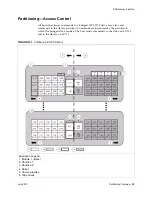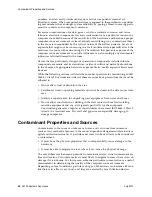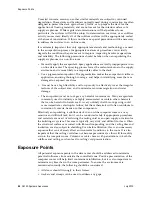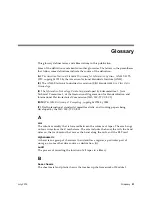
Room Conditions
July 2012
Controlling Contaminants
43
Shorts
Conductive pathways can arise through the accumulation of particles on circuit
boards or other components. Many types of particulate are not inherently conductive,
but can absorb significant quantities of water in high-moisture environments.
Problems caused by electrically conductive particles can range from intermittent
malfunctioning to actual damage to components and operational failures.
Thermal Failure
Premature clogging of filtered devices will cause a restriction in air flow that could
induce internal overheating and head crashes. Heavy layers of accumulated dust on
hardware components can also form an insulative layer that can lead to heat-related
failures.
Room Conditions
All surfaces within the controlled zone of the data center should be maintained at a
high level of cleanliness. All surfaces should be periodically cleaned by trained
professionals on a regular basis, as outlined in the
section. Particular attention should be paid to the areas beneath the
hardware, and the access floor grid. Contaminants near the air intakes of the
hardware can more easily be transferred to areas where they can do damage.
Particulate accumulations on the access floor grid can be forced airborne when floor
tiles are lifted to gain access to the sub-floor.
The subfloor void in a downward-flow air conditioning system acts as the supply air
plenum. This area is pressurized by the air conditioners, and the conditioned air is
then introduced into the hardware spaces through perforated floor panels. Thus, all
air traveling from the air conditioners to the hardware must first pass through the
subfloor void. Inappropriate conditions in the supply air plenum can have a dramatic
effect on conditions in the hardware areas.
The subfloor void in a data center is often viewed solely as a convenient place to run
cables and pipes. It is important to remember that this is also a duct, and that
conditions below the false floor must be maintained at a high level of cleanliness.
Contaminant sources can include degrading building materials, operator activity or
infiltration from outside the controlled zone. Often particulate deposits are formed
where cables or other subfloor items form air dams that allow particulate to settle
and accumulate. When these items are moved, the particulate is re-introduced into
the supply airstream, where it can be carried directly to hardware.
Damaged or inappropriately protected building materials are often sources of
subfloor contamination. Unprotected concrete, masonry block, plaster or gypsum
wall-board will deteriorate over time, shedding fine particulate into the air. Corrosion
on post-filtration air conditioner surfaces or subfloor items can also be a concern. The
subfloor void must be thoroughly and appropriately decontaminated on a regular
basis to address these contaminants. Only vacuums equipped with High Efficiency
Particulate Air (HEPA) filtration should be used in any decontamination procedure.
Inadequately filtered vacuums will not arrest fine particles, passing them through the
unit at high speeds, and forcing them airborne.
Summary of Contents for StorageTek SL150
Page 6: ...6 SL150 Systems Assurance July2012 ...
Page 8: ...8 SL150 Systems Assurance July2012 ...
Page 10: ...Access to Oracle Support 10 SL150 Systems Assurance July2012 ...
Page 18: ...Tape Drives and Media 18 SL150 Systems Assurance July2012 ...
Page 22: ...Tape Drive Cleaning 22 SL150 Systems Assurance July2012 ...
Page 32: ...Tape Slot Locations 32 SL150 Systems Assurance July2012 ...
Page 50: ...Activity and Processes 50 SL150 Systems Assurance July2012 ...
















































